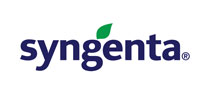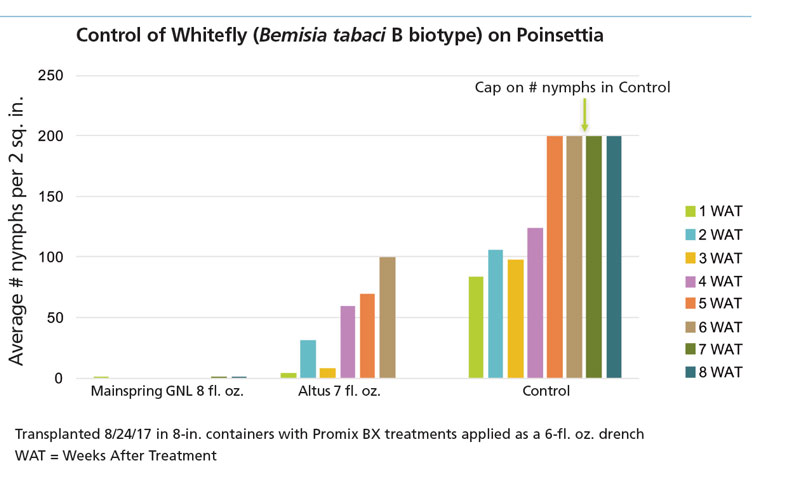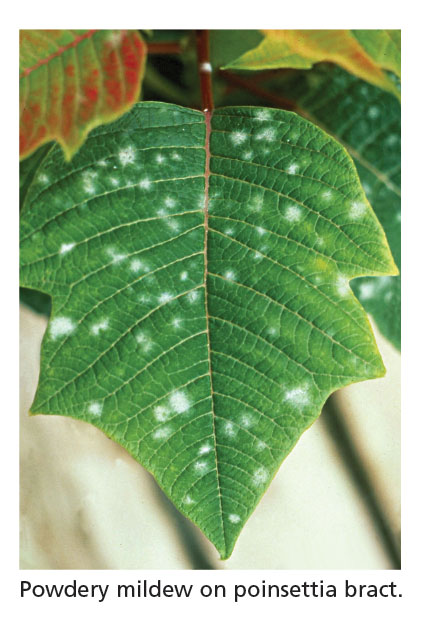7/1/2018
Protect Poinsettias from Propagation to Finish
Nancy Rechcigl

With fall quickly approaching, poinsettia production is gearing up. From propagation to finish, it’s important to continue monitoring for common disease and insect pests, particularly whiteflies, as they can build up quickly. Your scouting practices should include examining the underside of leaves. This will help you monitor pest pressure and gauge the performance of your control program.
Winning against whitefly
Whitefly tends to be the pest most attracted to poinsettia crops. Although there are numerous species in the U.S., the two most common are the greenhouse whitefly (Trialeurodes vaporariorum) and the silverleaf whitefly (Bemisia tabaci).
The silverleaf whitefly has multiple biotypes, including B and Q, which look identical and cannot be visually differentiated. Using biotyping to identify which species is present will determine the proper insecticide treatments. In general, newer insecticides are more effective against biotype Q.
Adult and immature whiteflies have piercing-sucking mouthparts they insert into the phloem and extract plant sap, which affects plant vigor. Nymphs cause the majority of damage, which can include:
• Reduced leaf expansion
• Chlorotic spots on top sides of leaves
• Leaf discoloration or silvering
• Leaf loss
• Presence of honeydew secretions on leaves that may result in black sooty mold on leaf surfaces
Scouting for whiteflies is essential, as their populations can build quickly in the greenhouse. Carefully examine the undersides of leaves for larvae and nymphs with a hand lens. Production facilities that don’t utilize a scouting program often rely on broad-spectrum calendar sprays or “curative” applications to gain control of established pest populations. This can result in unnecessary pesticide applications, may accelerate the development of resistance and are often not successful.

Systemic protection = Optimal control
Systemic insecticides from IRAC Group 4 have been the standard for controlling whiteflies in ornamentals. Today, there’s a unique option for systemic control with Mainspring GNL, a broad-spectrum insecticide from a novel class of chemistry known as diamides in IRAC Group 28.
Mainspring GNL can protect crops from a broad range of chewing and sucking pests, and prevent them from building to damaging levels. It’s an ideal solution for controlling Biotype B and Q whiteflies. As a drench, Mainspring GNL moves up through the plant to stop insects from feeding, thereby limiting plant injury.
Mainspring’s systemic protection delivers extended residual control (10+ weeks), which saves time and labor on repeat applications. Mainspring GNL can also be applied as a foliar spray on a 14-day interval when spray coverage isn’t a limiting factor. With a 4-hour re-entry interval (REI), Mainspring GNL applications can be made without disrupting production schedules.
For long, residual protection in poinsettia crops, apply Mainspring GNL as a drench two to three weeks after the crop is pinched and before whitefly populations begin to build. At this point, the crop is well-rooted after transplanting, which allows for optimal uptake of the systemic insecticide.

Managing common poinsettia diseases
Alternaria leaf spots, Botrytis and powdery mildew are just some diseases that can affect poinsettias. Each disease causes different symptoms to look for.
Alternaria leaf spots: This disease is often mistaken for Botrytis blight, but it’s more common in late summer and early fall. Alternaria leaf spots are a purplish-black color and become irregularly shaped as they expand in size, sometimes up to an inch long. They may cause leaf distortion, yellowing and leaf drop if the infection spreads.
Botrytis: While Alternaria leaf spots feature a dark purple rim, Botrytis causes small, light brown spots on foliage and flowers that often become V-shaped. Once established, the mold can quickly spread throughout the crop and production area. Thriving in cool, humid environments, Botrytis can be particularly problematic in the spring and late fall into winter.
Powdery mildew: Powdery mildew fungi form white, talcum-like spots on leaves, stems and flowers. Over time, they increase in size and number to cover the plant’s surface, reducing plant growth and causing leaves to turn yellow, brown and then drop. Powdery mildews are most likely to develop in the spring or fall.
Providing a clean, dry growing environment and checking incoming plants for signs of disease are two steps to help prevent these fungi. Applying a rotation of effective fungicides during production will protect the crop and ensure its quality once shipped. A broad-spectrum fungicide, such as Mural, is an essential component in rotation programs that target multiple diseases. Mural is powered by two active ingredients—Solatenol, an advanced generation SDHI, and azoxystrobin. It’s labeled to control more than 50 ornamental diseases from propagation to finish.
A comprehensive agronomic program
Syngenta offers a free agronomic program for poinsettia production that provides recommendations for preventing damage from several insects and diseases that can impact your crop.
The program recommends products based on their strengths, modes of action and length of control with applications timed so they’ll provide the maximum benefit. Recognizing that insect and disease pressure can vary in different regions, the program is meant to be a guide, providing solutions with a built-in resistance management strategy that will reduce pest problems, eliminate the need for corrective actions and ensure the production of a high-quality poinsettia crop.
The above excerpt of the agronomic program for poinsettias provides recommendations to help prevent targeted pests and diseases for the first seven weeks of production. The complete poinsettia agronomic program through Week 16 can be found at www.GreenCastOnline.com/Solutions. GT
Nancy Rechcigl is the field technical manager for ornamentals at Syngenta.